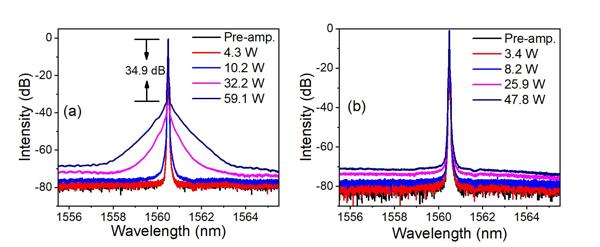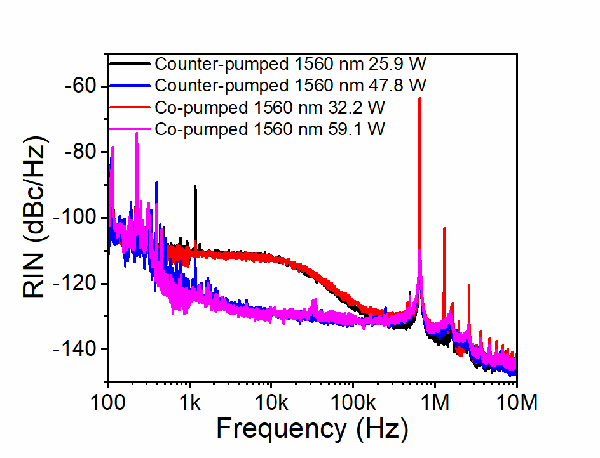The research fields related to high-power, single-frequency fiber lasers at 1.5 μm for coherent detection applications have rapidly expanded in recent years due to eye-safe properties and low transmission loss in the atmosphere and optical fiber. The laser power is limited by the Yb-Er energy transfer bottlenecking in Er-Yb co-doped fiber and the stimulated Brillouin scattering (SBS) in fiber when it is typically pumping by a 9XX nm diode laser. Direct pumping in the Er absorption band at 1480 nm is an effective way to avoid the bottlenecking problem and the high absorption in the fiber core reduces the length of the gain fiber, which increases the threshold of SBS.
High-power single-frequency amplifier at 1560 nm by in-band and core pumping of a 1480 nm Raman fiber laser is investigated in detail. The analysis of the relative intensity noise and spectrum with co- and counter-pumping configurations was published in High Power Laser Science and Engineering (Cheng, X., Lin, Z., Yang, X., Cui, S., Zeng, X., Jiang, H., & Feng, Y. (2023). High-power 1560 nm single-frequency erbium fiber amplifier core-pumped at 1480 nm. High Power Laser Science and Engineering, 11, e3.).

Figure 1. (a) Fine spectra in the co-pumped configuration of the 1560 nm laser at different output powers. There is an obvious background spectral broadening. (b) Fine spectra of the 1560 nm laser with the counter-pumped configuration at different powers. There is no obvious background spectral broadening.

Figure 2. RIN of 1560 nm signal laser at different output power by different pump manners. The 25.9 W and 32.2 W of 1560 nm signal laser correspond to 32 W of 1480 nm pump laser in counter pumping and co-pumping manner, respectively. The 47.8 W and 59.1 W of 1560 nm signal laser correspond to 61.7 W of 1480 nm pump laser in counter pumping and co-pumping manner, respectively.
This paper discusses the obvious spectral pedestal raise of the single-frequency amplifier related to cross-phase modulation between the pump and the signal laser. The walk-off effect between them can be used to suppress the nonlinear modulation process. And the noise characteristics of the 1560 nm laser are analyzed in detail. The pump noise affects the whole frequency range from 100 Hz to 10 MHz, rather than showing a common low-pass behavior.
The results have guiding significance for high-power SF rare-earth ion-doped fiber amplifiers, especially for in-band pumped amplifiers.


